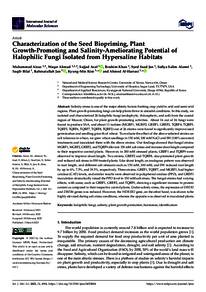Document
Characterization of the seed biopriming, plant growth-promoting and salinity-ameliorating potential of halophilic fungi isolated from hypersaline habitats.
Contributors
Ahmad, Waqar., Author
Asaf, Sajjad., Author
Khan, Ibrahim., Author
Jan, Syed Saad., Author
Al-Amriyah, Safiya Salim., Author
Bilal, Saqib., Author
Jan, Rahmatullah., Author
Kim, Kyung-Min., Author
Al-Harrasi, Ahmed., Author
Publisher
International Journal of Molecular Science.
Gregorian
2023-03
Language
English
English abstract
Salinity stress is one of the major abiotic factors limiting crop yield in arid and semi-arid
regions. Plant growth-promoting fungi can help plants thrive in stressful conditions. In this study, we
isolated and characterized 26 halophilic fungi (endophytic, rhizospheric, and soil) from the coastal
region of Muscat, Oman, for plant growth-promoting activities. About 16 out of 26 fungi were
found to produce IAA, and about 11 isolates (MGRF1, MGRF2, GREF1, GREF2, TQRF4, TQRF5,
TQRF5, TQRF6, TQRF7, TQRF8, TQRF2) out of 26 strains were found to significantly improve seed
germination and seedling growth of wheat. To evaluate the effect of the above-selected strains on
salt tolerance in wheat, we grew wheat seedlings in 150 mM, 300 mM NaCl and SW (100% seawater)
treatments and inoculated them with the above strains. Our findings showed that fungal strains
MGRF1, MGRF2, GREF2, and TQRF9 alleviate 150 mM salt stress and increase shoot length compared
to their respective control plants. However, in 300 mM stressed plants, GREF1 and TQRF9 were
observed to improve shoot length. Two strains, GREF2 and TQRF8, also promoted plant growth
and reduced salt stress in SW-treated plants. Like shoot length, an analogous pattern was observed
in root length, and different salt stressors such as 150 mM, 300 mM, and SW reduced root length
by up to 4%, 7.5%, and 19.5%, respectively. Three strains, GREF1, TQRF7, and MGRF1, had higher
catalase (CAT) levels, and similar results were observed in polyphenol oxidase (PPO), and GREF1
inoculation dramatically raised the PPO level in 150 mM salt stress. The fungal strains had varying
effects, with some, such as GREF1, GREF2, and TQRF9, showing a significant increase in protein
content as compared to their respective control plants. Under salinity stress, the expression of DREB2
and DREB6 genes was reduced. However, the WDREB2 gene, on the other hand, was shown to be
highly elevated during salt stress conditions, whereas the opposite was observed in inoculated plants.
Member of
Category
Journal articles


